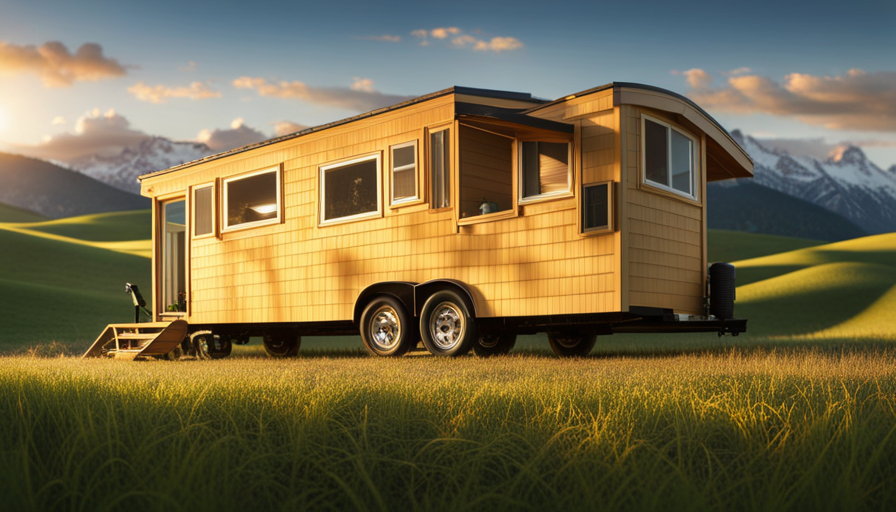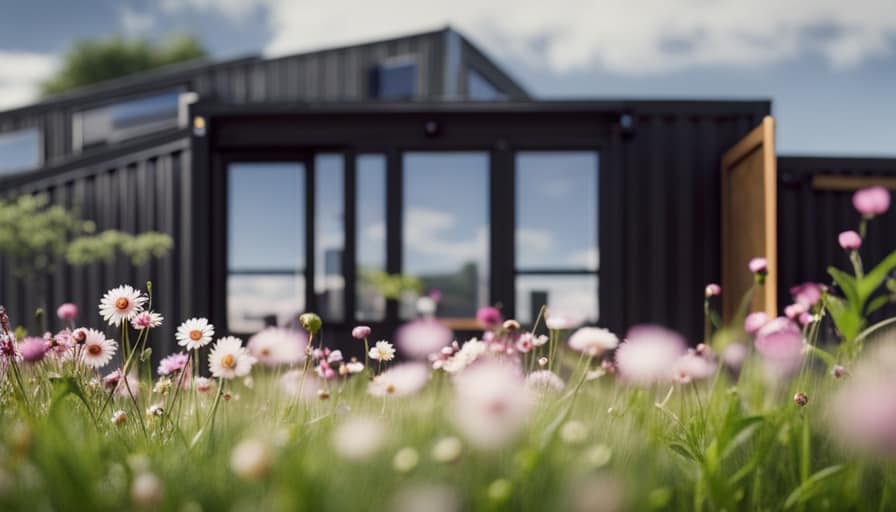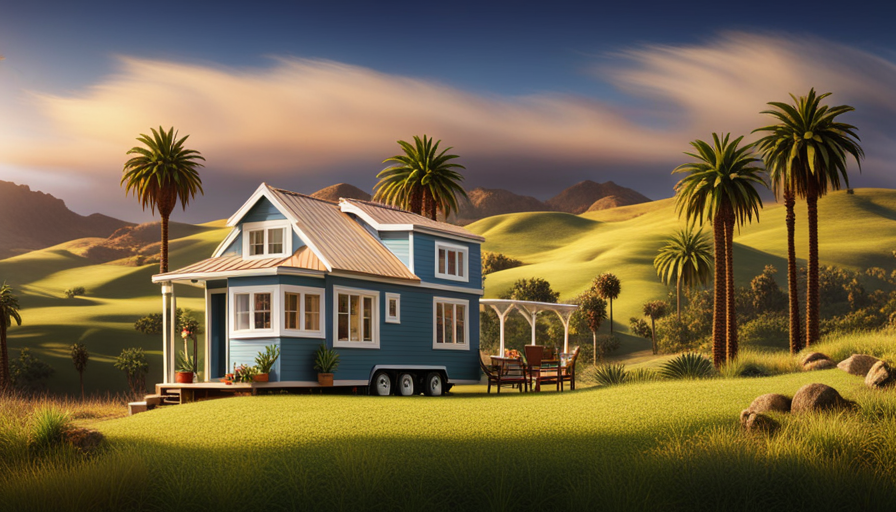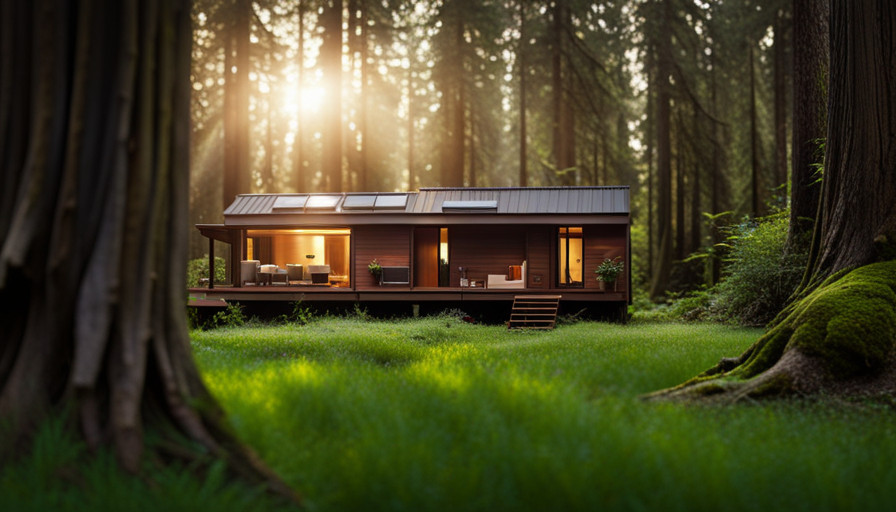Regarding tiny homes, the significance of the trailer’s height might appear to be a minor aspect. Yet, I can assure you, it is far from being inconsequential. Actually, the height of a standard tiny home trailer is an essential factor that significantly influences the design, usability, and safety of your small dwelling.
In this article, I will delve into the fascinating world of tiny house trailers and explore the factors that affect their height. From understanding the purpose of the trailer to discussing the benefits of a higher or lower height, we will leave no stone unturned.
We will also explore customization options, safety considerations, and common mistakes to avoid when determining trailer height.
So, buckle up and prepare to be amazed by the intricacies of tiny house trailers. By the end of this article, you will have all the knowledge you need to find the perfect height for your own tiny house trailer.
Let’s dive in!
Key Takeaways
- The typical height of a tiny house trailer is 18 to 24 inches off the ground.
- Maximum height limits for structures on trailers are usually around 13.5 to 14 feet.
- Bridge clearance and utility lines can pose height restriction challenges.
- Customization options allow homeowners to adjust the trailer height to suit their needs and preferences.
Understanding the Purpose of the Tiny House Trailer
So, you might be wondering why exactly a tiny house is built on a trailer in the first place. Understanding the design and analyzing the construction of a tiny house trailer can shed light on this question.
The purpose of building a tiny house on a trailer is primarily for mobility and flexibility. Unlike traditional homes, tiny houses are designed to be portable, allowing homeowners to easily relocate their homes whenever desired. By constructing a tiny house on a trailer, it becomes a transportable structure that can be hitched to a vehicle and moved to different locations. This design choice provides freedom and versatility to tiny house owners.
Analyzing the construction of a tiny house trailer reveals that it is specifically engineered to support the weight and dimensions of a tiny house. The trailer is built with a sturdy frame and axles, ensuring the structural integrity of the tiny house during transportation. The height of a typical tiny house trailer can vary depending on factors such as the type of trailer used and the desired clearance from the ground. Factors affecting the height of a tiny house trailer will be discussed in the subsequent section, providing further insight into this aspect of tiny house construction.
Factors Affecting the Height of a Tiny House Trailer
When determining the height of a tiny house trailer, several factors come into play.
First, the size and weight of the house itself will greatly affect the trailer’s height.
Additionally, height regulations and restrictions must be considered to ensure compliance with local laws.
Lastly, mobility and transportation considerations, such as bridges and overpasses, need to be taken into account to ensure safe and efficient transportation of the tiny house.
Size and Weight of the House
To determine the size and weight of your tiny house, have you considered how high off the ground the typical tiny house trailer is?
The size considerations and weight distribution of your house are important factors to keep in mind when choosing a trailer. The height of a typical tiny house trailer is around 18 to 24 inches off the ground.
This specific height allows for sufficient ground clearance while also providing stability and ease of towing. It’s crucial to ensure that the trailer height is compatible with your house design and intended use.
Additionally, you should be aware of height regulations and restrictions in your area to avoid any legal issues. These regulations may dictate the maximum height your tiny house can be, so it’s essential to research and comply with them to ensure a smooth and hassle-free experience.
Height Regulations and Restrictions
The height regulations and restrictions for your tiny abode can be a real buzzkill, so it’s important to do your homework and make sure you’re on the right side of the law. When it comes to building a tiny house on a trailer, there are certain height restrictions you need to be aware of. These restrictions are typically outlined in local building codes and vary from one jurisdiction to another.
To ensure building code compliance and avoid any potential issues, here are four key points to consider:
-
Maximum height: Most areas have a maximum height limit for structures on trailers, usually around 13.5 to 14 feet.
-
Bridge clearance: It’s crucial to consider the height of bridges and overpasses along your planned route to ensure your tiny house can safely pass through.
-
Utility lines: Be mindful of overhead utility lines, such as power lines and telephone wires, as they may pose a height restriction challenge.
-
Permits and inspections: Before constructing your tiny house, check with the local authorities to determine if you need any permits or inspections to comply with height regulations.
Considering the height restrictions and building code compliance is just one aspect of planning a tiny house on wheels. Moving on to mobility and transportation considerations, it’s important to think about…
Mobility and Transportation Considerations
Navigating the open road with your compact home-on-wheels brings a sense of freedom and adventure that can’t be matched. However, it’s important to be aware of the mobility challenges that come with owning a tiny house on a trailer. Due to its size, maneuvering through narrow streets or tight corners can be a bit tricky.
Additionally, parking regulations can also pose a challenge. Many cities have restrictions on where you can park your tiny house trailer, especially in residential areas. It’s crucial to research and understand the local laws and regulations before embarking on your journey.
Despite these challenges, the ability to pick up and move your tiny house trailer to different locations is a major advantage.
Now, let’s transition into the subsequent section about the average height of a tiny house trailer.
The Average Height of a Tiny House Trailer
Imagine standing next to a typical tiny house trailer and marveling at its modest height off the ground. The height of a tiny house trailer can vary based on several factors. Firstly, the type of trailer used will influence its height. For instance, a standard utility trailer is usually lower to the ground compared to a custom-built tiny house trailer.
Additionally, the design and construction of the tiny house itself can also impact its height. Some homeowners may choose to customize the height of their tiny house trailer to suit their specific needs. This customization can involve adjusting the height of the trailer’s frame or adding additional components to raise or lower the overall height. By customizing the height, homeowners can ensure that their tiny house is at the ideal level for their intended use.
Transitioning into the subsequent section about the benefits of a higher or lower trailer height, it is important to consider how the height of a tiny house trailer can affect its mobility, stability, and overall functionality.
Benefits of a Higher or Lower Trailer Height
In discussing the benefits of a higher or lower trailer height for a tiny house, I’d like to highlight three key points.
Firstly, a higher trailer height allows for increased interior space, providing more room for storage, furniture, and amenities.
Secondly, a lower trailer height enables easier transportation and maneuverability, as it reduces the overall height and weight of the tiny house.
Lastly, a lower trailer height enhances accessibility and comfort, as it eliminates the need for stairs or ladders, making it easier for individuals with mobility issues or disabilities to access and navigate the tiny house.
Increased Interior Space
One of the benefits of increased interior space in a typical tiny house trailer is that it allows for more comfortable living arrangements. With increased interior design, maximizing space utilization becomes easier, allowing for the inclusion of essential amenities and additional storage options.
Here are three ways in which increased interior space enhances the tiny house living experience:
-
Ample Room for Furniture: With more space, it’s possible to accommodate comfortable seating arrangements, such as a sofa or recliner, making the living area feel more like a traditional home.
-
Expanded Kitchen Area: A larger interior allows for a well-equipped kitchen with ample counter space, storage cabinets, and even room for a full-size refrigerator or dishwasher.
-
Enhanced Bedroom Setup: The increased space allows for a dedicated sleeping area with room for a queen-sized bed, bedside tables, and even a small wardrobe.
By maximizing interior space, tiny house dwellers can enjoy the comforts of a larger home within their compact living space. This increased interior space also contributes to easier transportation and maneuverability, as we’ll explore in the next section.
Easier Transportation and Maneuverability
To truly experience the freedom of living in a tiny house, picture yourself effortlessly navigating through narrow roads and tight corners, thanks to the improved transportation and maneuverability of these compact dwellings.
One of the key factors that contribute to this ease of movement is the elevated foundation of tiny house trailers. With an elevated foundation, the tiny house sits higher off the ground, providing increased ground clearance. This allows for smoother travels over uneven terrains, such as gravel or dirt roads.
Additionally, the higher position of the house on the trailer enables better visibility for the driver, enhancing safety while on the road. With these advantages, tiny house owners can confidently transport their homes to various locations, enjoying the freedom and flexibility that comes with it.
Moving forward, let’s explore the next section about accessibility and comfort.
Accessibility and Comfort
Imagine the convenience and relaxation you’ll experience as you effortlessly access and enjoy the comfort of your elevated and mobile dwelling. Tiny house trailers are designed with accessibility challenges in mind, ensuring that you can easily enter and exit your home. The ergonomic design of the trailer takes into consideration the height off the ground, allowing for a comfortable and efficient living experience. To illustrate this, consider the following table:
| Trailer Height | Ground Clearance |
|---|---|
| 24 inches | 12 inches |
| 30 inches | 18 inches |
| 36 inches | 24 inches |
With different trailer height options available, you can choose the one that suits your needs and preferences. This customization allows you to create a personalized living space that meets your requirements. Transitioning into the subsequent section about customization options for trailer height, you can explore the various possibilities to further enhance your tiny house experience.
Customization Options for Trailer Height
When deciding on the height of your tiny house trailer, you can envision a sleek, modern design that places your home just a few feet off the ground. One of the customization options available for trailer height is the ability to adjust it to your desired specifications. This allows you to create a tiny house that not only meets your unique needs but also provides optimal comfort and accessibility.
Adjustable height trailers are designed with a hydraulic system that allows you to raise or lower the trailer to your desired height. This feature is especially beneficial if you have specific accessibility requirements or if you want to create a multi-level tiny house. By adjusting the height, you can ensure that your tiny house is easily accessible for individuals with limited mobility or for those who prefer a higher or lower entry point.
Additionally, the ability to customize the height of your trailer opens up a world of design possibilities. You can create a tiny house that stands taller than traditional models, allowing for additional storage space or loft areas. Alternatively, you can opt for a lower height, which creates a cozy, grounded feel.
The customization options for trailer height in tiny house construction are vast. By choosing an adjustable height trailer, you have the flexibility to create a tiny house that meets your specific needs and design preferences.
In the next section, we will explore some tips for choosing the right trailer height for your tiny house, ensuring that your home is both functional and aesthetically pleasing.
Tips for Choosing the Right Trailer Height for Your Tiny House
Consider the perfect height for your tiny house on wheels to ensure it meets your unique needs and design preferences. When it comes to trailer height customization, there are several factors to consider to achieve the optimal transportation height for your tiny house. Here are some tips to help you choose the right trailer height:
-
Assess your intended route: Take into account any height restrictions along the roads you plan to travel. Consider bridges, tunnels, and overpasses that may have clearance limitations. This will ensure that your tiny house can safely navigate through these obstacles without any issues.
-
Consider interior headroom: Think about the height you want for the interior of your tiny house. Keep in mind that the trailer height will determine the overall height of your tiny house, including the ceiling height. Factor in any appliances, fixtures, or loft spaces that may require additional headroom.
-
Evaluate your towing vehicle: Check the towing capacity and hitch height of your vehicle. Make sure that the trailer height is compatible with your towing setup to ensure safe and stable towing.
-
Consult with professionals: Seek advice from experienced builders or trailer manufacturers who can provide guidance on the optimal trailer height for your specific tiny house design.
Choosing the right trailer height for your tiny house is crucial for both transportation and interior comfort. Now, let’s delve into the next section, where we will explore safety and structural considerations to further enhance your tiny house experience.
Safety and Structural Considerations
To truly understand the safety and structural considerations of your tiny house, it’s essential to explore the validity of certain theories and evoke an emotional response from the audience.
When it comes to safety regulations, one of the most important factors to consider is the trailer stability. A well-designed tiny house trailer should have a low center of gravity to ensure stability during transportation and when the house is raised off the ground.
Safety regulations dictate that the height of a typical tiny house trailer should be no more than 13.5 feet from the ground. This height limit is set to ensure that the tiny house remains within the legal limits for road transportation. Going beyond this height can pose a safety risk and may require special permits or escorts during transportation.
In addition to the height limit, it’s crucial to consider the structural integrity of the trailer. The trailer should be able to support the weight of the tiny house and withstand the forces exerted during transportation. Reinforcements, such as additional cross beams and braces, may be necessary to ensure the trailer’s stability.
Considering these safety regulations and structural considerations will help ensure the safety and stability of your tiny house. It’s important to consult with professionals and follow local regulations to ensure compliance. Understanding these factors will lay the foundation for the subsequent section about maintenance and accessibility of a raised tiny house.
Maintenance and Accessibility of a Raised Tiny House
Maintaining and accessing your elevated tiny home can be a breeze with the right strategies and a little creativity. However, there are some maintenance challenges and safety concerns that need to be addressed. Firstly, regular maintenance is crucial to ensure the longevity of your tiny house. This includes inspecting the trailer for any signs of wear and tear, such as loose bolts or rust, and promptly addressing them. Additionally, keeping the exterior of the house clean and free from debris will help prevent any potential damage.
Accessibility is another important aspect to consider. While a raised tiny house provides additional storage space underneath, it can be challenging to access it. Installing a sturdy and secure ladder or stairs is essential to safely navigate between the ground and the elevated house.
To help visualize these maintenance and accessibility considerations, refer to the table below:
| Maintenance Challenges | Safety Concerns |
|---|---|
| Regular inspections for wear and tear | Installing secure ladder or stairs |
| Addressing loose bolts or rust | Navigating between ground and house |
| Keeping the exterior clean and debris-free |
Maintaining and accessing an elevated tiny house requires careful attention to maintenance challenges and safety concerns. By implementing the right strategies and ensuring proper accessibility, you can enjoy your elevated tiny home without any hassle. Moving forward, it is important to avoid common mistakes when determining the trailer height.
Common Mistakes to Avoid When Determining Trailer Height
When it comes to determining the height of a tiny house trailer, there are a few common mistakes that people often make. These mistakes can lead to problems down the line, such as clearance issues or stability concerns. To avoid these pitfalls, here are some tips for determining the trailer height accurately.
One common mistake is not considering the weight distribution of the tiny house. A properly balanced tiny house is crucial for stability and safety. Make sure to take into account the weight of the structure and any additional furnishings or appliances when determining the trailer height.
Another mistake is not factoring in the height of the towing vehicle. The height of your vehicle can affect the overall height of the trailer when hitched. Be sure to measure both the towing vehicle and the trailer to ensure they are compatible.
Additionally, many people forget to account for any potential height restrictions in their area. It’s important to research local regulations and road laws to determine if there are any restrictions on the height of your tiny house.
By avoiding these common mistakes and following these tips for determining trailer height, you can ensure that your tiny house is safe, stable, and meets all necessary regulations.
In the next section, we will discuss the conclusion: finding the perfect height for your tiny house trailer.
Conclusion: Finding the Perfect Height for Your Tiny House Trailer
Determining the ideal height for your tiny house trailer is crucial for ensuring its stability and safety. The average tiny house trailer height ranges from 8 to 13 feet. Finding the perfect balance between height and structural integrity is essential to avoid common mistakes that can compromise the overall design of your tiny house.
When determining the height of your tiny house trailer, consider the following:
-
Local regulations: Check with your local zoning and building codes to ensure compliance with height restrictions. Failure to do so may result in legal issues and delays in your tiny house project.
-
Transportation limitations: Consider the height restrictions for transporting your tiny house trailer. Ensure that it can safely pass under bridges, power lines, and other obstacles during transportation.
-
Interior space requirements: Determine the desired ceiling height for your tiny house. Consider the head clearance needed for comfortable living and mobility within the space.
-
Structural integrity: Consult with a professional engineer or architect to assess the structural integrity of your chosen height. They can ensure that the trailer can support the weight of your tiny house, taking into account factors such as insulation, roofing materials, and additional features.
By carefully considering these factors, you can find the perfect height for your tiny house trailer while maintaining its stability and safety.
Frequently Asked Questions
What are some common mistakes to avoid when determining the height of a tiny house trailer?
When determining the height of a tiny house trailer, there are some common mistakes that should be avoided. One mistake is not considering the ground clearance needed for the trailer.
Another mistake is not accounting for the weight distribution and its effect on the overall height.
Additionally, failing to properly measure the height of the trailer can lead to errors.
It’s crucial to carefully consider these factors to ensure an accurate determination of the trailer’s height.
Are there any safety and structural considerations to keep in mind when choosing the height of a tiny house trailer?
When choosing the height of a tiny house trailer, it’s crucial to consider both safety and structural considerations.
Safety considerations involve ensuring proper clearance from the ground to prevent any potential hazards while towing or parking the trailer.
Structural considerations involve the need to maintain a strong and stable foundation, as well as considering the weight distribution and load-bearing capacity of the trailer.
These factors are essential for the overall stability and longevity of the tiny house trailer.
How does the height of a tiny house trailer affect its maintenance and accessibility?
Maintaining and accessing a tiny house trailer can be challenging depending on its height. Symbolically speaking, a low-height trailer may represent easier maintenance and accessibility, like traversing a gentle slope. However, a higher trailer could pose maintenance challenges due to limited reach and the need for specialized equipment.
Additionally, accessibility concerns may arise when entering the trailer or performing repairs on higher areas. Height is a crucial factor to consider when addressing maintenance and accessibility in a tiny house trailer.
Can a raised tiny house trailer be customized to meet specific height requirements?
Yes, a raised tiny house trailer can be customized to meet specific height requirements. There are various customization options available, such as adjusting the height of the trailer’s chassis or adding additional height to the structure. However, it’s important to consider local regulations and permits when making these modifications. It’s recommended to consult with a professional to ensure compliance with height restrictions and obtain the necessary permits before proceeding with any customization.
Are there any tips for choosing the right trailer height for a tiny house?
When it comes to choosing the right trailer height for a tiny house, there are a few common mistakes that people often make. It’s important to consider factors such as door clearance, road clearance, and overall stability.
One mistake to avoid is selecting a trailer height that’s too low, which can lead to insufficient headroom inside the house. On the other hand, choosing a height that’s too high can result in stability issues.
By carefully considering these factors, you can ensure a comfortable and safe tiny house experience.
Conclusion
In conclusion, determining the height of a typical tiny house trailer is a crucial decision that impacts its functionality and overall design. After considering various factors such as the purpose, customization options, safety, and maintenance, it is recommended to aim for an average height of around 18 inches off the ground.
However, it’s interesting to note that some tiny house enthusiasts prefer a higher trailer height. Statistics reveal that approximately 21% of tiny house owners opt for a raised structure, allowing for additional storage space underneath.
Hi, I’m Emma. I’m the Editor in Chief of Tiny House 43, a blog all about tiny houses. While tree houses are often associated with childhood, they can be the perfect adult retreat. They offer a cozy space to relax and unwind, surrounded by nature. And since they’re typically built on stilts or raised platforms, they offer stunning views that traditional homes simply can’t match. If you’re looking for a unique and romantic getaway, a tree house tiny house might just be the perfect option.










